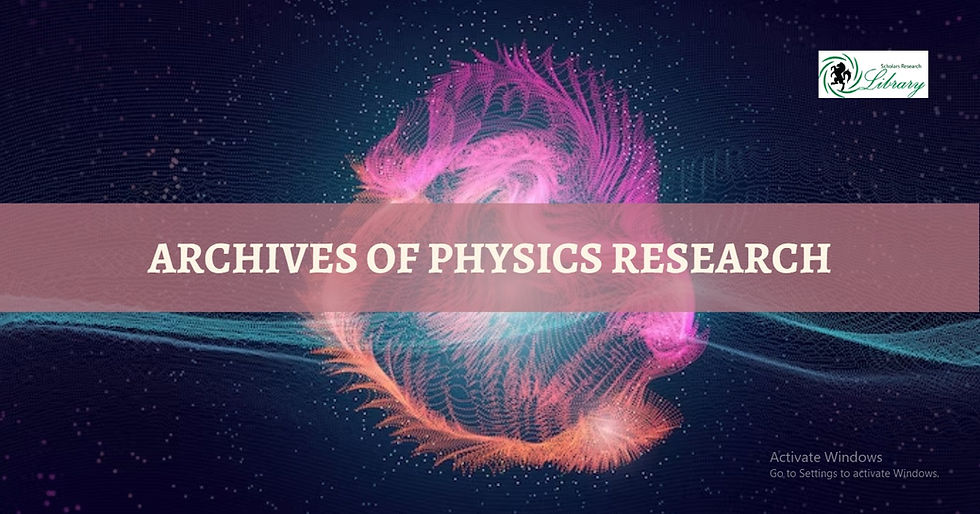Particle Physics: Exploring the Properties and Interactions of Subatomic Particles
- Journal Series
- Jun 27, 2023
- 3 min read

Introduction
Particle physics is a fascinating area of examination that investigates the fundamental constructing blocks of the universe and their interactions. By exploring the houses and conduct of subatomic debris, researchers and scholars in this area liberate the secrets and techniques of the universe's composition and delve into the character of counted and energy. In this blog, we will delve into the importance and importance of particle physics, speak the Standard Model of Particle Physics, discover particle accelerators and detectors, understand particle interactions and decay, delve into quantum field principles and symmetries, ponder the realm beyond the Standard Model, spotlight experimental discoveries and milestones, talk modern research and destiny instructions, and take a look at the technological applications and benefits that rise up from particle physics research. This blog put up is adapted to researchers and students from pinnacle universities worldwide and draws from the ultra-modern studies findings within the Physics Research Journal.
The Standard Model of Particle Physics
The Standard Model is a theoretical framework that describes the fundamental debris and their interactions. Key points to don't forget are:
Quarks and leptons: Quarks are the constructing blocks of protons and neutrons, even as leptons consist of debris inclusive of electrons and neutrinos.
Gauge bosons: This debris mediates the fundamental forces, along with the photon for electromagnetism and the W and Z bosons for susceptible interactions.
Particle Accelerators and Detectors
Particle accelerators and detectors play a crucial position in analyzing subatomic debris. Important elements encompass:
Large Hadron Collider (LHC): The LHC, placed at CERN, is the sector's maximum powerful particle accelerator, colliding debris at excessive energies to probe the essential components of remember.
Detectors: Sophisticated detectors, inclusive of the ATLAS and CMS detectors, seize the particles from particle collisions and provide treasured facts for evaluation.
Particle Interactions and Decay
Particles interact through fundamental forces, and understanding their interactions is important. Key factors consist of:
Electromagnetic interactions: Particles with electric-powered price interact via the trade of photons, ensuing in phenomena that include scattering and radiative decay.
Weak interactions: Weak interactions govern procedures including radioactive decay and neutrino interactions, mediated through the W and Z bosons.
Quantum Field Theory and Symmetries
The quantum field idea provides a mathematical framework for describing the conduct of debris and its interactions. Important elements consist of:
Symmetry standards: Symmetries, along with gauge symmetries and Lorentz symmetry, play a vital function in know-how particle physics and conservation legal guidelines.
Feynman diagrams: Feynman diagrams constitute particle interactions and allow researchers to calculate the chance of numerous strategies.
Beyond the Standard Model
While the Standard Model is tremendously successful, it leaves unanswered questions and gaps in our information. Some key regions of exploration encompass:
Dark matter: The nature of dark count number, which constitutes a great portion of the universe's mass, remains one of the best mysteries in particle physics.
Neutrino masses: The discovery that neutrinos have mass demanding situations the Standard Model and call for an extension to explain their homes.
Experimental Discoveries and Milestones
Particle physics has witnessed groundbreaking discoveries at some stage in history. Notable milestones consist of:
Discovery of the Higgs boson: In 2012, the ATLAS and CMS experiments on the LHC introduced the invention of the Higgs boson, confirming its role in particle mass technology.
Neutrino oscillations: Experimental observations of neutrino oscillations provided proof that neutrinos have mass and may exchange among unique flavors.
Current Research and Future Directions
Particle physics keeps pushing the bounds of expertise. Current studies regions and destiny instructions encompass:
Precision measurements: Researchers intend to refine measurements of recognized debris and interactions to check the boundaries of the Standard Model.
Neutrino physics: The look at neutrinos, their loads, and their houses holds the potential to free up new physics past the Standard Model.
Technological Applications and Benefits
Particle physics research has far-achieving technological packages and advantages. Examples include:
Medical imaging: Techniques advanced for particle detectors, which include positron emission tomography (PET), have revolutionized scientific imaging and diagnostics.
Data processing and computing: High-performance computing techniques advanced for reading great quantities of particle physics statistics have observed applications in numerous fields.
Conclusion
Particle physics plays a pivotal position in unraveling the mysteries of the universe and knowledge of the fundamental nature of matter and power. By exploring the Standard Model, particle accelerators and detectors, particle interactions and decay, quantum field idea, the world beyond the Standard Model, experimental discoveries, present-day studies, and technological programs, researchers and pupils from top universities globally contribute to the development of know-how in this discipline. The Physics Research Journal serves as an invaluable useful resource, providing modern-day research findings and fostering collaboration amongst researchers. As particle physics maintains to develop, new frontiers and thrilling discoveries look ahead, providing a deeper understanding of the subatomic realm and its implications for our understanding of the universe.
If you want to learn more about quantum computing, then click here.
Comments